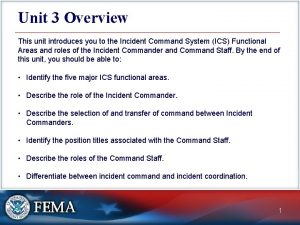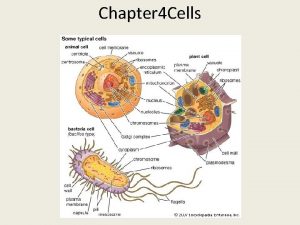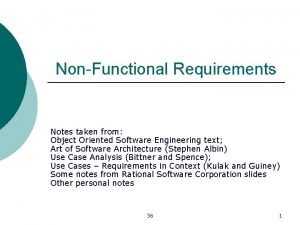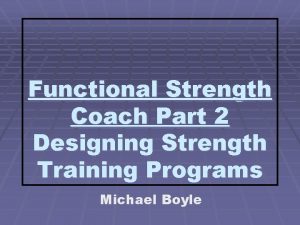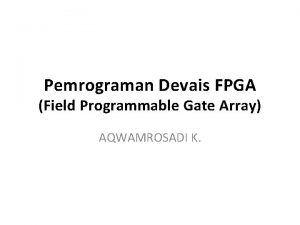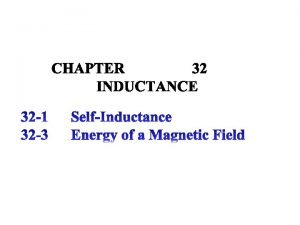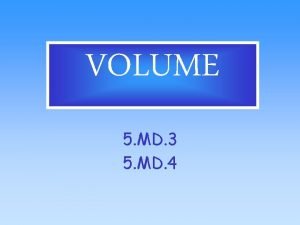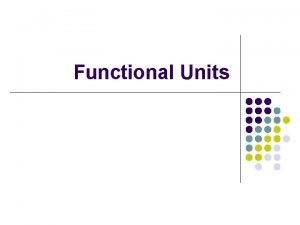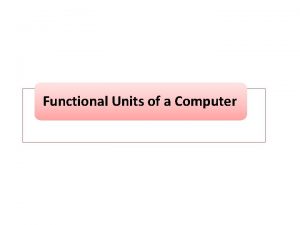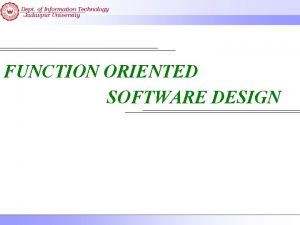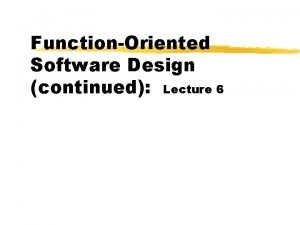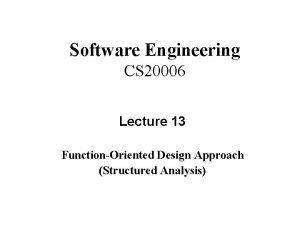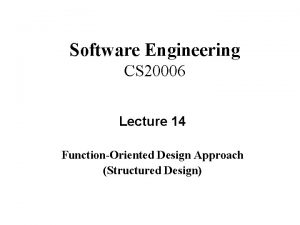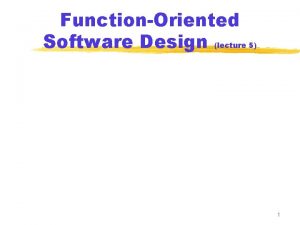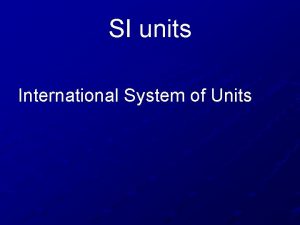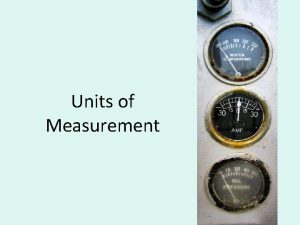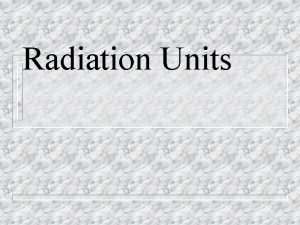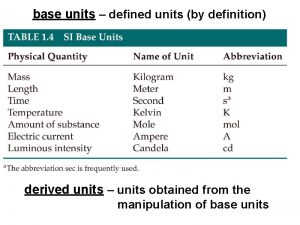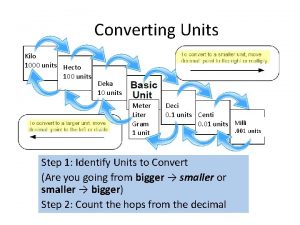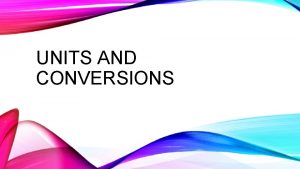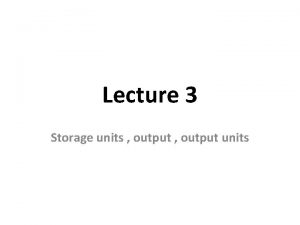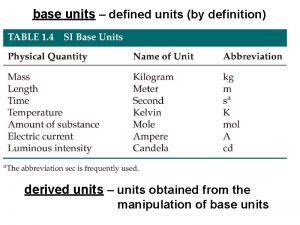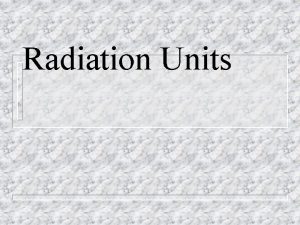Functionoriented Design u Design with functional units which


















- Slides: 18

Function-oriented Design u Design with functional units which transform inputs to outputs ©Ian Sommerville 1995 Software Engineering, 5 th edition. Chapter 15 Slide 1

Topics Covered u u u Data flow design Structural decomposition Detailed design ©Ian Sommerville 1995 Software Engineering, 5 th edition. Chapter 15 Slide 2

Natural Functional Systems u u Some systems are naturally function-oriented Systems which maintain minimal state information; i. e. , where the system is concerned with processing independent actions whose outcomes are not affected by previous actions Information sharing through parameter lists Transaction processing systems fall into this category. Each transaction is independent. ©Ian Sommerville 1995 Software Engineering, 5 th edition. Chapter 15 Slide 3

ATM Software Design loop Print_input_message (” Welcome - Please enter your card”) ; exit when Card_input ; end loop ; Account_number : = Read_card ; Get_account_details (PIN, Account_balance, Cash_available) ; if Validate_card (PIN) then loop Print_operation_select_message ; case Get_button is when Cash_only => Dispense_cash (Cash_available, Amount_dispensed) ; when Print_balance => Print_customer_balance (Account_balance) ; when Statement => Order_statement (Account_number) ; when Check_book => Order_checkbook (Account_number) ; end case ; Eject_card ; Print (“Please take your card or press CONTINUE”) ; exit when Card_removed ; end loop ; Update_account_information (Account_number, Amount_dispensed) ©Ian Sommerville 1995 Software Engineering, 5 th edition. Chapter ; 15 Slide 4

Functional and Object-oriented Design u u For many types of applications, object-oriented design is likely to lead to a more reliable and maintainable system. For applications that maintain little state, functionoriented design is appropriate. Standards, methods, and CASE tools for functional design are well-established. Existing systems must be maintained. Functionoriented design will be practiced well into the 21 st century. ©Ian Sommerville 1995 Software Engineering, 5 th edition. Chapter 15 Slide 5

Functional Design Process u Data flow design • u Structural decomposition • u Model the data processing in the system using data flow diagrams Model how functions are decomposed into sub-functions using graphical structure charts Detailed design • The entities in the design and their interfaces are described in detail. These may be recorded in a data dictionary and the design expressed using a PDL ©Ian Sommerville 1995 Software Engineering, 5 th edition. Chapter 15 Slide 6

Data Flow Diagrams u u Show an input data item is functionally transformed by a system into an output data item Are an integral part of many design methods and are supported by many CASE systems ©Ian Sommerville 1995 Software Engineering, 5 th edition. Chapter 15 Slide 7

DFD Notation u u u Rounded rectangle - function or transform Rectangle - data store Circles - user interactions with the system Arrows - show direction of data flow keywords and/or - Used to link data flows ©Ian Sommerville 1995 Software Engineering, 5 th edition. Chapter 15 Slide 8

Design Report Generator ©Ian Sommerville 1995 Software Engineering, 5 th edition. Chapter 15 Slide 9

Structural Decomposition u u u Structural decomposition is concerned with developing a model of the design which shows the dynamic structure; i. e. , function calls. The aim of the designer should be to derive design units which are highly cohesive and loosely coupled. In essence, a data flow diagram is converted to a structure chart. ©Ian Sommerville 1995 Software Engineering, 5 th edition. Chapter 15 Slide 10

Decomposition Guidelines u u u For business applications, the top-level structure chart may have four functions, namely input, process, master-file-update, and output Data validation functions should be subordinate to an input function. Coordination and control should be the responsibility of functions near the top of the hierarchy. ©Ian Sommerville 1995 Software Engineering, 5 th edition. Chapter 15 Slide 11

Decomposition Guidelines u u The aim of the design process is to identify loosely coupled, highly cohesive functions. Each function should therefore do one thing and one thing only. Each node in the structure chart should have between two and seven subordinates. ©Ian Sommerville 1995 Software Engineering, 5 th edition. Chapter 15 Slide 12

Process Steps u Identify system processing transformations • u Identify input transformations • u Transformations in the DFD that are concerned with processing rather than input/output activities. Group under a single function in the structure chart Transformations concerned with reading, validating and formatting inputs. Group under the input function Identify output transformations • Transformations concerned with formatting and writing output. Group under the output function ©Ian Sommerville 1995 Software Engineering, 5 th edition. Chapter 15 Slide 13

Initial Structure Chart ©Ian Sommerville 1995 Software Engineering, 5 th edition. Chapter 15 Slide 14

Expanded Structure Chart ©Ian Sommerville 1995 Software Engineering, 5 th edition. Chapter 15 Slide 15

Final Structure Chart ©Ian Sommerville 1995 Software Engineering, 5 th edition. Chapter 15 Slide 16

Detailed Design u u u Concerned with producing a short design specification (mini-spec) of each function. This should describe the processing, inputs, and outputs. These descriptions should be managed in a data dictionary. From these descriptions, detailed design descriptions, expressed in a PDL, can be produced. ©Ian Sommerville 1995 Software Engineering, 5 th edition. Chapter 15 Slide 17

Data Dictionary Entries ©Ian Sommerville 1995 Software Engineering, 5 th edition. Chapter 15 Slide 18
 K
K When units manufactured exceed units sold:
When units manufactured exceed units sold: Functional and non functional space maintainer
Functional and non functional space maintainer Functional and non functional plasma enzymes
Functional and non functional plasma enzymes Plasma enzyme
Plasma enzyme Functional and non functional
Functional and non functional The deputy incident commander will be replacing
The deputy incident commander will be replacing Which of the following is true about functional text?
Which of the following is true about functional text? Which is the basic functional unit of life?
Which is the basic functional unit of life? Non functional requirements system design
Non functional requirements system design Functional training program design
Functional training program design Apakah tujuan dari functional simulation dalam design flow
Apakah tujuan dari functional simulation dalam design flow Early american floral arrangement
Early american floral arrangement Lucy calkins writing units
Lucy calkins writing units Unit for specific heat
Unit for specific heat Energy stored in inductor
Energy stored in inductor Gallon man
Gallon man Frequency units
Frequency units 24 cubic units
24 cubic units






